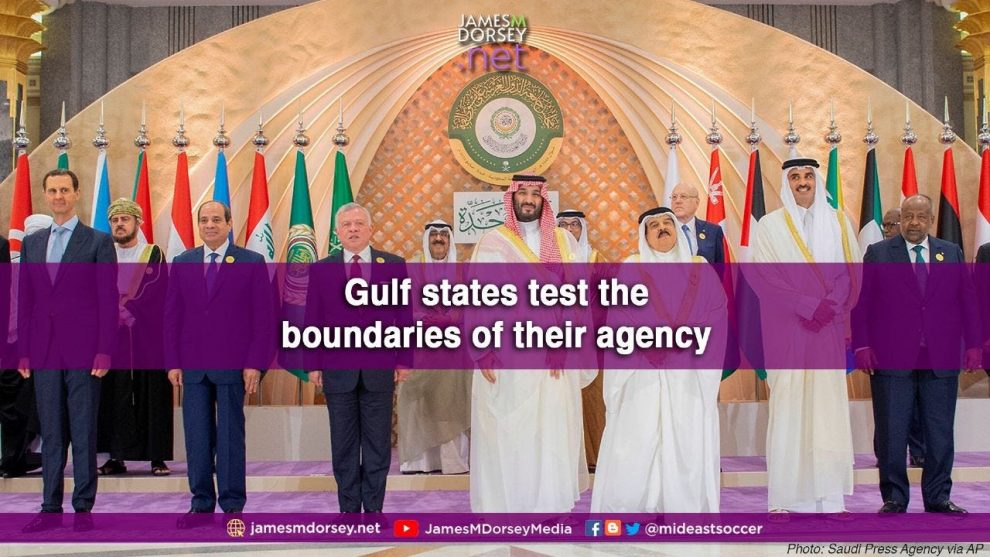More than three years after burying the war hatchet, erstwhile Gulf rivals are moving in separate ways as they maneuver big power competition.
Ironically, anti-Islamists like Saudi Arabia and the United Arab Emirates have drifted towards greater independence from the United States while Qatar, long seen as a haven for the Muslim Brotherhood and other Islamists, is hueing closer to the region’s long-standing security partner.
The UAE and Saudi Arabia led a 3.5-year-long diplomatic and economic boycott of Qatar in a failed bid to force it to change its policies and break its ties to the Brotherhood and others. The embargo was lifted in 2020.
Since then, the UAE has spearheaded efforts to return Syrian President Bashar al-Assad to the Arab fold, improve relations between Iran and the conservative Gulf states, and accommodate Russian efforts to circumvent Ukraine-related US and European sanctions.
Saudi Arabia last month hosted Mr. Al-Assad at an Arab League summit in Jeddah. Mr. Al-Assad’s presence ended the League’s suspension of Syria’s membership a decade ago because of his brutal conduct during the country’s civil war.
The United States opposed Mr. Al-Assad’s rehabilitation and has vowed to maintain its sanctions on Syria.
In support of the US, Qatari Emir Tamim bin Hamad Al Thani left the summit before Mr. Al-Assad addressed the Jeddah gathering.
Mr. Al-Thani’s walkout demonstrated Qatar’s deepening ties to the United States in response to the UAE-Saudi-led boycott. Last year, NATO designated Qatar a major non-NATO ally for its role in the US evacuation from Afghanistan.
The deepening ties have not stopped Qatar, home to the largest US military base in the Middle East, from keeping its lines open to China, among others, by granting the People’s Republic access to Hamad Port and purchasing Chinese ballistic missiles.
Even so, Qatar, in contrast to the UAE, has been careful not to irritate the United States or stray too far from US policies.
In the latest move to chart its own course, the UAE recently pulled out of a US-led maritime security force, the Combined Maritime Forces (CMF).
Led by a US admiral, the CMF groups 38 countries, including Qatar and Saudi Arabia, in a bid to halt Iranian attacks on commercial ships, weapons smuggling, and piracy.
The UAE said its withdrawal was part of an assessment of “effective security cooperation” in the Middle East.
The UAE foreign ministry maintained that “the UAE is committed to peaceful dialogue and diplomatic engagement as a means of advancing the shared goals of regional security and stability.”
The Emirati withdrawal follows Iran’s recent seizure of two oil tankers in the Strait of Hormuz. One of the tankers was travelling between two Emirati ports, Dubai and Fujairah, when it was attacked. The attacks reinforced Emirati doubts about the US ability and/or willingness to protect Gulf shipping.
In response to the seizures, the US announced increased allied patrols in the Strait but did not send additional ships or personnel to the region.
Similarly, like the UAE, Saudi Arabia increasingly appears willing to go against US policies. It has resisted US pressure to recognise Israel. The US sees recognition as crucial to its efforts to fashion an integrated regional air defense that would allow the United States to rejigger its security commitment to the Gulf.
By attaching conditions to potential recognition, including a firm US defense commitment and support for a Saudi civilian nuclear programme, Saudi Arabia has created a litmus test for US attitudes towards the kingdom.
Saudi Arabia has rejected US preconditions for nuclear cooperation, including a demand that it follow the UAE’s example and surrender its right to extract, enrich or process uranium.
At a mining conference in January, Saudi Oil Minister Abdulaziz bin Salman Al Saud insisted that the kingdom seeks to own “the entire nuclear fuel cycle which involves the production of yellowcake, low-enriched uranium and the manufacturing of nuclear fuel.”
In response, the kingdom turned to China. As a result, China and Saudi Arabia extended nuclear cooperation beyond uranium exploitation to nuclear technology last month.
The stepped-up cooperation follows a Chinese-mediated agreement between Saudi Arabia and Iran to restore diplomatic relations. Relations ruptured in 2016 after mobs stormed the kingdom’s diplomatic missions in protest against the execution of a prominent Saudi Shiite cleric.
While competing on multiple levels, Saudi Arabia and the UAE gamble that they can successfully play the United States and China against one another as they position themselves as regional leaders. In doing so, they place big bets.
China has a significant interest in Gulf security but has neither the ability nor the will to replace the United States as a guarantor.
Meanwhile, Gulf states remain dependent on an external guarantor.
Their large-scale sophisticated arms acquisitions have yet to enable them to create credible fighting forces. Their inability is not due to lack of resources. Instead, they have shied away from turning their militaries into fighting forces fearing that these could challenge monarchical rule.
Consequently, Saudi Arabia is groping for a face-saving exit from its failed eight-year-old military intervention in Yemen. At the same time, the UAE has established a string of strategic outposts along the Red Sea and in the Horn of Africa that it may not be able to defend sustainably.
“Saudi-US relations are achieving a renewed equilibrium. The UAE is still testing the waters and brinkmanship while Qatar plays it safe. There’s an element of bluff poker in this. But, sooner or later, reality will reassert itself, and the Gulf states will accept that dependence on a security guarantor comes at a price,” said a Western diplomat.






